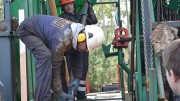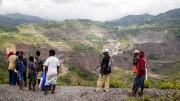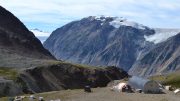Santa Rosalia, Baja California Sur–John Greenslade is probably one of the most tenacious–and brilliant–chief executives in the junior mining world.
Since staking a large copper-cobalt-zinc deposit called Boleo on the east coast of Mexico’s Baja peninsula in 1992, the president and chief executive of Baja Mining (BAJ-T, BAJFF-O) has completed three separate rounds of financing for the project- the first in 2007, the second in 2008, and the third in 2010.
Escalating capital costs across the industry conspired to sink the first round when Baja Mining revised its capex numbers in line with inflation, and the financial crisis torpedoed the second. But giving up is just not in Greenslade’s DNA.
“It’s an ore body and you don’t give up on ore bodies,” he says during a recent tour of the site. “Just because the financial markets collapse the ore body doesn’t go away. It’s been there for eight million years.”
So in June 2009, Greenslade started all over again and by November 2010 had raised more than US$1 billion for the US$889.5 million project.
Greenslade likes to say that “anyone who has ever done their homework on Boleo is a believer.”
And the way things are looking these days those believers–and there are many of them–stand to make a very good return on their investment.
Boleo is a permitted, fully funded project that will produce its first copper and cobalt cathode metal in the second quarter of 2013, with zinc sulphate monohydrate, and at a later stage, possibly manganese, as by-product credits.
The mine will have a lifespan of about 23 years with net cash costs that will be the envy of the industry at negative US$0.29 per lb. copper.
In terms of revenue distribution, copper will make up about 66%, cobalt 25% and zinc 9%.
The sedimentary deposit is made up of seven flat-lying soft-rock ore beds that are close to surface. It was formed in a shallow marine basin, near the shore around volcanic islands.
At a 0.5% copper-equivalent cut-off, Boleo has measured and indicated resources of 265 million tonnes grading 0.76% copper, 0.06% cobalt, 0.64% zinc and 1.5% manganese. Of that, 85 million tonnes fall in the proven and probable reserve category grading 1.34% copper, 0.08% cobalt, 0.55% zinc and 2.91% manganese. Inferred resources add 160 million tonnes grading 0.47% copper, 0.045% cobalt, 0.70% zinc, and 1.15% manganese.
During its first six years of production, Boleo is scheduled to produce 125 million pounds of copper annually at a copper grade of above 2%, along with 3.7 million pounds of cobalt and 55.8 million pounds of zinc sulphide.
In years seven through twenty-three, Boleo will turn out about 84 million pounds of copper a year at an average grade of 1.33%, in addition to 3.6 million pounds of cobalt and 65 million pounds of zinc sulphide.
At a copper price of US$2.91 per lb., US$26.85 per lb. cobalt and 53¢ per lb. zinc, Boleo will have an after-tax net present value, at an 8% discount rate, of about US$1.3 billion, with an after-tax internal rate of return of 26%, according to an updated feasibility study completed in March 2010.
Baja Mining owns 70% of Boleo and the remaining 30% is owned by a consortium of Korean companies consisting of Korea Resources Corp. (Kores), LS-Nikko Copper, Iljin Materials, SK Networks, and Hyundai Hysco. The consortium signed an agreement in June 2008-providing a US$50 million loan and a commitment to pay 30% of all construction costs. The consortium has the right to 30% of copper and cobalt production.
Other key shareholders include Mount Kellett Capital, a New York-headquartered private equity group, with about 17% of the junior’s outstanding shares, Manulife AM (U.S.) with 7%, Louis Dreyfus 5%, Manulife AM Ltd. 4%, and JPMorgan 4%. (Global commodities trader Louis Dreyfus also has an off-take agreement for Baja Mining’s 70% share of production for the first ten years of production.)
Among its financial bankers is the Export-Import Bank of the United States, (US Exim) which came in with a US$420 million, fourteen-year fixed loan at the remarkably low interest rate of 3.02%.
“We are the smallest company they had ever dealt with and it’s the largest loan they have ever done with the mining industry,” Greenslade says. “And where have you ever seen an interest rate of 3%?”
Not only that, but the loan documentation was completed and signed off in just fourteen months, he says, less than half the 36 months it typically takes the bank to complete a loan.
Despite its high-profile backers and the massive size of its resource, Baja Mining’s shares remain undervalued versus its peer group–fluctuating over the last year between a low of 54¢ and $1.39 per share.
One reason is there are critics who claim that the challenge of getting the metal out of the clay makes Boleo a risky project.
But Baja’s management maintains that improvements to solid-liquid separation technology have made Boleo a viable project and point to the more than 20 operating mines around the world that currently use the technology successfully, including the Sepon mine in central Laos.
“Everywhere they’ve used this technology it’s worked at or above design capacity,” says Greenslade, who holds a masters in mining engineering and a law degree.
Baja Mining also has on its staff one of the premier metallurgists in the world, David Dreisinger, a professor at the University of British Columbia who co-invented the process for copper recovery at Sepon as well as at Mt. Gordon, an open-pit copper mine about 120 km northwest of Mt Isa in Australia.
Dreisinger co-developed the technology used at the Sepon mine, now owned by MMG Resources, part of China’s Minmetals Group. That mine entered production in March 2005 and within just nine months of start-up, Dreisinger says, was operating at full design capacity.
“The solid-liquid separation technology has been very successful with these high clay content ores,” he explains in a telephone interview on the eve of a flight to Sepon, where he has consulted for the better half of the last decade. “It has been working well and continues to improve over time.”
One of the key features at Boleo is its use of high rate thickeners that have further fine-tuned the solid-liquid separation process, the company explains. High rate thickeners are essentially devices used to wash the cobalt, copper, zinc and manganese from the residue–technology that wasn’t available in the 1990s when companies like International Curator, part of the Lundin Group (LUN-T), first looked at Boleo.
“At that time conventional solid-liquid separation technology wasn’t adequate for the job,” Dreisinger explains. “The high rate thickeners weren’t widely available back in the mid-1990s.”
International Curator eventually walked away from Boleo and the Lundins decided instead to put their money into Tenke-Fungurume, a copper project in the Democratic Republic of the Congo.
High rate thickeners have changed the playing field at Boleo and projects like it around the world. Also called deep well thickeners, they are now the standard for dealing with solid-liquid separation in clay-type environments such as with laterite, saprolite and montmorillinite clay. While they are referred to as thickeners, it is actually a washing step in which the metal-rich aqueous solution is washed away from the clay. In pilot tests at Boleo the efficiency rate runs between 98% and 99%.
Baja Mining says Sherritt International‘s (S-T) Ambatovy nickel laterite project is scheduled to use high rate thickeners in Madagascar, and Vale (VALE-N) is looking at the technology for its Goro nickel project in New Caledonia, one of the world’s largest undeveloped laterite deposits.
Greenslade notes that solid-liquid separation technology has been most often used in nickel laterite projects, which historically ha
ven’t had problems with the solid-liquid separation process itself, but rather with their pressure leach circuits, as in the case of the spectacular failure of the Bulong nickel laterite project in Kalgoorlie, Western Australia.
“The problem with Bulong wasn’t the solid-liquid separation technology it was that the pressure leach system didn’t work,” Greenslade explains. “But there are still people who don’t believe it. When I met with one of the better base metal geologists around and gave him a list of 17 different projects that use the technology, he immediately pointed to Bulong as an example of where it hadn’t work. I said yes, but the solid-liquid separation there worked fine. I still get that question from people about Boleo.”
Ironically Baja Mining stands to benefit from the scepticism that still lingers around the more complex metallurgy, despite having proven it works during test operations by SGS Lakefield at two pilot plants (November 2004 and June-July 2006) and in two underground mining trials (October 2005 and October 2006).
“If it weren’t for the solid-liquid separation problems with clay this ore body would have been mined out fifty or one hundred years ago,” Greenslade says.
In addition to the high rate thickening technology Baja Mining will be using to resolve the difficulties posed by Boleo’s clay, Dreisinger notes that the company is also using a direct solvent extraction (DSX) technique created by the Commonwealth Scientific and Industrial Research Organization, or CSIRO, Australia’s national science agency. DSX involves the use of two commercially available reagents (specifically a mixture of known solvent extractants that have both been in use since the 1960s) to recover zinc and cobalt and reject manganese from the copper solvent extraction raffinate feed.
“This was a big breakthrough back in 2004 when this technology was announced by the CSIRO,” Dreisinger explains. “We pounced on it right away and have tested it in all of our pilot plants to make sure if fits properly with our circuit.”
Adam Low, a mining analyst at Raymond James in Toronto who visited Boleo in July 2010, believes the market has undervalued the company.
“I think it’s cheap,” he says. “There will always be some doubters just given the complex metallurgy but between now and production start in 2013 we will certainly see the valuation creep up.”
Low, who looks at companies on a price to net asset value metric, notes that based on Baja’s close on July 6 at $1.10 per share, it is trading at 0.43 times price/NAV while a lot of the base metal development companies trade at 0.4 times and don’t even have financing, permitting or feasibility studies in place. He also points out that base metal producers typically are trading at between 0.7 to 1.1 times price/NAV.
“I would expect Baja to trade at something higher than they are currently given they are much further ahead than most other development companies,” he says.
And it’s not just that Baja Mining is more advanced than other base metal development companies in terms of financing, permitting, and feasibility, he adds, it also has off-take agreements, strong partners in the Korean consortium and Louis Dreyfus, and are in construction.
“Now that Anvil Mining (AVM-T) and Copper Mountain (CUM-T) have completed the construction of their mines, Baja is essentially the next company that will be making the transition from a development company to a producer,” he says.
Low has a buy on the stock with a 12-month target price of $1.90 per share.
On a recent 40-degree Celsius day in June, visitors to the site, including Mexico’s Secretary of Economy, Bruno Ferrari, and Marcos Alberto Covarrubias Villasenor, the governor of Baja California Sur, watched from air-conditioned coaches as workers sprayed water across the construction site to keep the dust down.
Earthworks began in December 2010 and hydraulic excavators, front-end loaders, tractor bulldozers and hauling trucks arrived in the first quarter of this year. Surface mining activities began in the first week of May.
A cement batch plant is now operating and Baja is completing basic engineering, and receiving more mining equipment. During the third quarter, underground mining is expected to begin, as is construction of the tailings storage facility and marine terminal. In the fourth quarter the company expects to finish most of the engineering and receive the milling equipment and scrubbers.
Boleo’s design includes underground and open-cut mines, although about 95% of the ore will come from underground mining using the room-and-pillar method. The underground mines will be accessed via adits in outcrops on the sides of the canyons.
The company will build a hydrometallurgical processing plant, a desalination facility, a marine terminal, and a sulphuric acid and power cogeneration plant.
The hydrometallurgical plant will include a two-stage leaching process (an oxidising leach and a reducing leach), solid-liquid separation, and a solvent extraction (SX-EW) unit operation. There will be two electro-winning circuits to produce the LME Grade A copper cathode and the high-purity cobalt cathode.
The majority of the process (crushing, milling and leaching) will run on sea water-taken from the Sea of Cortez, or Gulf of California–500 metres from the site on the other side of the state of Baja California Sur’s primary highway. The highway is adjacent to the property and extends from the U.S. border in the north to Cabo San Lucas in the south.
Sea water will be used in the grinding and leaching circuits, while fresh water (provided by on-site desalination and steam from the acid plant) will be used for electro-winning.
The 2,400-tonne-per day sulphuric acid plant will have a heat recovery system and a steam turbine and generator that will produce roughly 46 megawatts of power. The plant will burn sulphur that will produce the majority of the power necessary for the project’s processing plant, electro-winning and desalination facilities.
The ore body extends 2-4 km in width from east to west and about 15 km in length. Of the seven ore beds, ore bed number four is the deepest at about 80 metres, and typically the different beds are separated by a few tens of metres. The footwall on most of them is primarily conglomerate with a very well-defined contact.
The French (Compagnie du Boleo) mined the deposit between 1880 and 1934, during which time they mined about 14 million tonnes at an average grade of 4.8% copper but in the early years were mining plus 20% copper, Greenslade says. “Anything less than 3.5% copper was considered waste by them.”
In 1900 they built a refinery, which burned down in 1921 and was rebuilt. The remnants of the building are in town to this day-as is a church designed by Gustave Eiffel, the designer of the Eiffel Tower in Paris.
The town of Santa Rosalia, 805 km from Mexico’s border with the United States, was actually built by the French for this mine, Greenslade explains, and is the only French-built town in the country. Today the town of about 12,000 people depends primarily on fishing and gypsum mining.
In addition to Boleo’s copper, cobalt and zinc, Greenslade says the company is planning a 10,000 metre, US$2.3 million drill program this year to explore the deposit at depth.
It is also trying to figure out what to do with Boleo’s significant manganese content, which the current mine plan doesn’t take into account. (Baja believes Boleo is the sixth-largest manganese deposit in the world.) The deposit has a proven and probable mineral reserve grade of 2.91% and contains about 2.5 million tonnes of manganese metal.
It would be easy to produce the metal on site as a manganese carbonate concentrate, Greenslade says, but the market for manganese carbonate in North America is about 30,000 tonnes a year. (When manganese carbonate is processed further, it can be used to make man
ganese metal, electrolytic manganese dioxide and other specialty manganese chemicals.)
A year ago Baja Mining approached a number of Chinese refineries at the Manganese Institute’s conference in Paris but there wasn’t much interest, Greenslade says. But at this year’s conference in Korea the company talked with five or six metal refineries that were interested in taking feedstock from Boleo.
“If we could market that it could add about US$50 million a year to our net operating profits.”
In a research note to clients in April, Low of Raymond James wrote that adding a manganese revenue stream “has potential to increase our NAV by 33%.”
In April, Baja’s board approved a shareholder rights plan to ensure the fair treatment of shareholders in the event of any take-over bid for the company’s common shares.
“Once we are in production, I do think we are a takeover target,” says Greenslade, adding that he “strongly suspects” there is “at least one-mid-tier producer with underground experience and with some experience in clay that may be looking at us discreetly right now.”
“Someone might want to take us out because we are going to generate a lot of cash flow,” he notes. “At current metal prices we would probably generate somewhere around 70-75¢ a share in after-tax revenues. With those kinds of earnings, pick your multiple. We are usually conservative as we can’t predict what will happen, but others have expressed that we could expect to increase by eight times. Most of the mid-tier producers are trading in the fourteen- to twenty-times earnings range.”
Sums up Dreisinger, Baja Mining’s vice president metallurgy: “Boleo is an undiscovered gem. We’re hoping to set the world on fire.”





Be the first to comment on "Baja Mining’s Boleo project is worth waiting for"